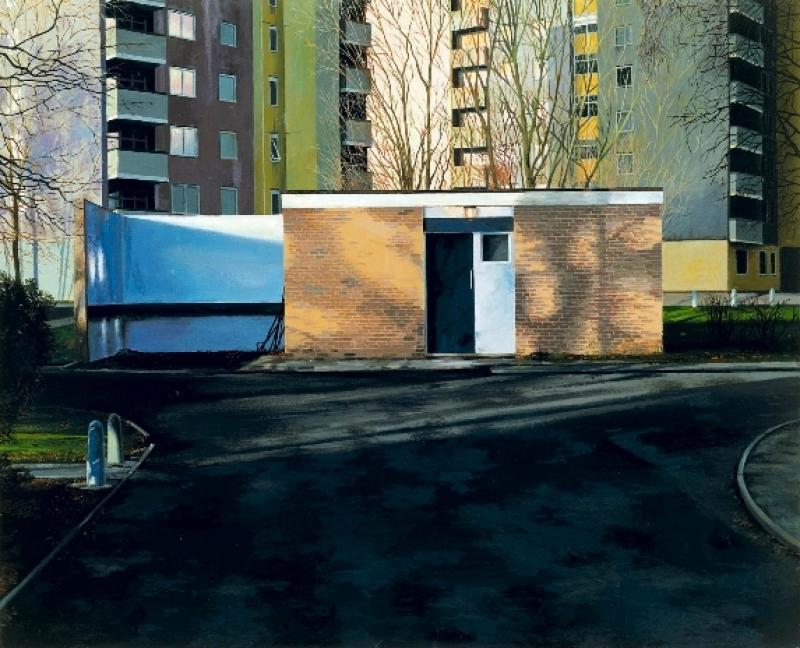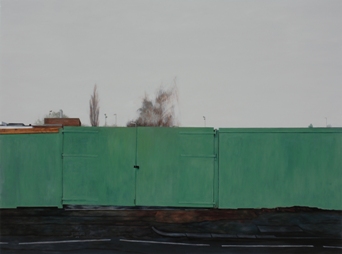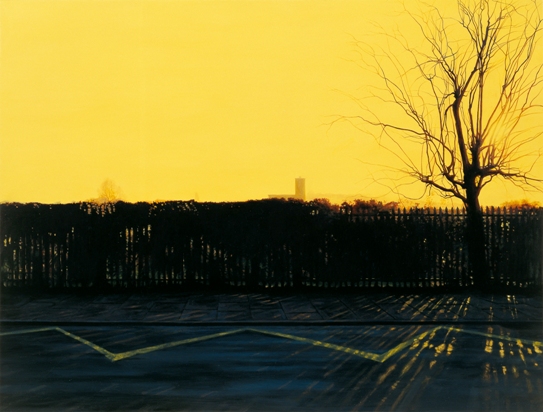George Shaw: The Sly and Unseen Day, South London Gallery | reviews, news & interviews
George Shaw: The Sly and Unseen Day, South London Gallery
George Shaw: The Sly and Unseen Day, South London Gallery
An impressive exhibition of paintings hark back to a lost, Larkinesque England

By anyone’s standards this is an obscure year for the Turner Prize shortlist: you should consider yourself a contemporary art aficionado if you’ve heard of even one of the artists. And if this is indeed the case, that artist is likely to be George Shaw; in recent years his work has featured regularly in group displays at Tate Britain.
To say that Shaw celebrates the mundane and the everyday is not quite how one might describe what he does, for a sense of celebration is hardly the pervasive mood; with the title of the exhibition taken from Tess of the d’Urbervilles, where Hardy ponders his doomed heroine's last day on earth, that mood is often one of foreboding. Yet with Shaw's meticulous attention to detail and consummate skill, these muted paintings offer a quiet, and quietly seductive, celebration of the realist tradition.
For the last 15 years the artist has painted the two square miles around the estate in which he spent his childhood. Tile Hill, in Coventry, is wholly typical of the council estates that were built in England in mass social housing projects in the Sixties and Seventies. Now they are run-down: libraries, shops and pubs are closed; graffiti and splashes of paint daub walls; subways are unlit, ominous places.
 Selecting from the thousands of images he has taken over that time, Shaw has painted every nook and cranny of the place from photographs. These usually close-up, squarely aligned paintings include boarded windows, fencing (pictured right: No Return, 2009), concrete steps, a concrete tunnel entrance, a disused children’s swing, minus swings. But also the serenely luscious wooded areas that surround the estate. And though evidence of life is all around, there is never a person or vehicle to be seen.
Selecting from the thousands of images he has taken over that time, Shaw has painted every nook and cranny of the place from photographs. These usually close-up, squarely aligned paintings include boarded windows, fencing (pictured right: No Return, 2009), concrete steps, a concrete tunnel entrance, a disused children’s swing, minus swings. But also the serenely luscious wooded areas that surround the estate. And though evidence of life is all around, there is never a person or vehicle to be seen.
These paintings are both disquieting and really rather nostalgic. They depict a lost Larkinesque England where there’s never anything to do on rainy Sundays and where buttoned-up lives of desperate loneliness are lived behind net curtains. Instead of traditional oil paint, Shaw uses Humbrol enamels, used to paint Airfix models and reminiscent of a Seventies boyhood. Its hard, sheeny surface keeps us locked out, deflects entry beyond that lacquered shell, as does Shaw's preference for painting obstructing gates, fences, shuttered windows and walls.
 Once very modest in scale, these paintings have progressively been scaled-up in both size and ambition. The larger works here are among the strongest of the 15 on show. One of the most arresting is Ash Wednesday, 8.30am, 2004-5 (pictured left), with its sulphur-yellow sky, spindly silhouette of a lone tree against an end-to-end stretch of fence - very Hockney - and the faint, smokey traces of tower blocks in the far distance. Another is Scenes from The Passion: The Cop Shop, 1999-2000 (main picture), where two tower blocks rise up either side of a one-storey brick building (which looks more like an outhouse than a police station). The religious references, a nod to Shaw’s boyhood Catholicism, underline an elegiac mood. With their sense of order and restraint, restricted palette and adherence to structure, one might even be reminded of Dutch paintings of the golden age, shed of their certainties and material satisfactions. This really is an impressive exhibition.
Once very modest in scale, these paintings have progressively been scaled-up in both size and ambition. The larger works here are among the strongest of the 15 on show. One of the most arresting is Ash Wednesday, 8.30am, 2004-5 (pictured left), with its sulphur-yellow sky, spindly silhouette of a lone tree against an end-to-end stretch of fence - very Hockney - and the faint, smokey traces of tower blocks in the far distance. Another is Scenes from The Passion: The Cop Shop, 1999-2000 (main picture), where two tower blocks rise up either side of a one-storey brick building (which looks more like an outhouse than a police station). The religious references, a nod to Shaw’s boyhood Catholicism, underline an elegiac mood. With their sense of order and restraint, restricted palette and adherence to structure, one might even be reminded of Dutch paintings of the golden age, shed of their certainties and material satisfactions. This really is an impressive exhibition.
- George Shaw: The Sly and Unseen Day at South London Gallery until 3 July
Share this article
Add comment
The future of Arts Journalism
You can stop theartsdesk.com closing!
We urgently need financing to survive. Our fundraising drive has thus far raised £49,000 but we need to reach £100,000 or we will be forced to close. Please contribute here: https://gofund.me/c3f6033d
And if you can forward this information to anyone who might assist, we’d be grateful.

Subscribe to theartsdesk.com
Thank you for continuing to read our work on theartsdesk.com. For unlimited access to every article in its entirety, including our archive of more than 15,000 pieces, we're asking for £5 per month or £40 per year. We feel it's a very good deal, and hope you do too.
To take a subscription now simply click here.
And if you're looking for that extra gift for a friend or family member, why not treat them to a theartsdesk.com gift subscription?
more Visual arts
 'We are bowled over!' Thank you for your messages of love and support
Much-appreciated words of commendation from readers and the cultural community
'We are bowled over!' Thank you for your messages of love and support
Much-appreciated words of commendation from readers and the cultural community
 Edward Burra, Tate Britain review - watercolour made mainstream
Social satire with a nasty bite
Edward Burra, Tate Britain review - watercolour made mainstream
Social satire with a nasty bite
 Ithell Colquhoun, Tate Britain review - revelations of a weird and wonderful world
Emanations from the unconscious
Ithell Colquhoun, Tate Britain review - revelations of a weird and wonderful world
Emanations from the unconscious
 Rachel Jones: Gated Canyons, Dulwich Picture Gallery review - teeth with a real bite
Mouths have never looked so good
Rachel Jones: Gated Canyons, Dulwich Picture Gallery review - teeth with a real bite
Mouths have never looked so good
 Yoshitomo Nara, Hayward Gallery review - sickeningly cute kids
How to make millions out of kitsch
Yoshitomo Nara, Hayward Gallery review - sickeningly cute kids
How to make millions out of kitsch
 Hamad Butt: Apprehensions, Whitechapel Gallery review - cool, calm and potentially lethal
The YBA who didn’t have time to become a household name
Hamad Butt: Apprehensions, Whitechapel Gallery review - cool, calm and potentially lethal
The YBA who didn’t have time to become a household name
 Bogancloch review - every frame a work of art
Living off grid might be the meaning of happiness
Bogancloch review - every frame a work of art
Living off grid might be the meaning of happiness
 Do Ho Suh: Walk the House, Tate Modern review - memories are made of this
Home sweet home preserved as exquisite replicas
Do Ho Suh: Walk the House, Tate Modern review - memories are made of this
Home sweet home preserved as exquisite replicas
 Ed Atkins, Tate Britain review - hiding behind computer generated doppelgängers
Emotions too raw to explore
Ed Atkins, Tate Britain review - hiding behind computer generated doppelgängers
Emotions too raw to explore
 Echoes: Stone Circles, Community and Heritage, Stonehenge Visitor Centre review - young photographers explore ancient resonances
The ancient monument opens its first exhibition of new photography
Echoes: Stone Circles, Community and Heritage, Stonehenge Visitor Centre review - young photographers explore ancient resonances
The ancient monument opens its first exhibition of new photography
 Hylozoic/Desires: Salt Cosmologies, Somerset House and The Hedge of Halomancy, Tate Britain review - the power of white powder
A strong message diluted by space and time
Hylozoic/Desires: Salt Cosmologies, Somerset House and The Hedge of Halomancy, Tate Britain review - the power of white powder
A strong message diluted by space and time

Comments
...
...